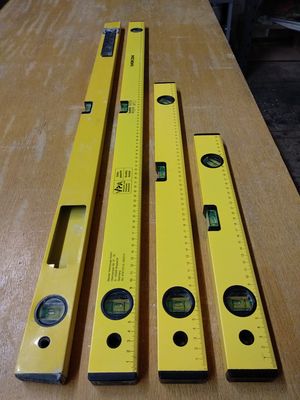Levels: Difference between revisions
m (Location:: for SMW) |
m (German name) |
||
| Line 1: | Line 1: | ||
{{ToolInfoBox | {{ToolInfoBox | ||
|tool name=Level | |tool name=Level | ||
|german=Wasserwaagen | |||
|image=wasserwage.jpg | |image=wasserwage.jpg | ||
|synonyms=spirit level, bubble level; DE: Wasserwaage | |synonyms=spirit level, bubble level; DE: Wasserwaage | ||
Revision as of 23:07, 18 February 2022
| ToolInfoBox Level | |
|---|---|

| |
| Synonyms: | spirit level, bubble level; DE: Wasserwaage |
| Type: | measuring tool |
| Location: | wood workshop |
| Access Requirements: | read this page |
| Similar (More or Less): | inclinometer |
A level uses a bubble floating in a liquid-filled tube to indicate whether something is parallel or perpendicular (or, in some models, at a 45° angle), to the ground earth's gravitational field.
When mounting something, that means if the floor or wall nearby is not perfectly straight, your measurement will be - so there could be applications where you'd rather go for a line parallel to the existing geometry than the "true" measurement obtained with a level.
Given the proper conditions you can also check squareness of pieces against each other in two dimensions, but a square is the proper tool for this kind of task.
Small magnetic or clip-on levels can be very handy if you have a straight reference (e.g. your workpiece or a tensioned string) to attach it to.